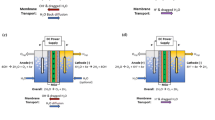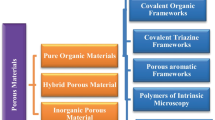Abstract
Three different types of cation exchangers were produced from four basic poly(styrene–divinylbenzene) substrates with different properties. Porous PS-DVB resin beads were functionalized by sulfonation and sulfoacylation under various conditions to produce sulfonated resins with exchange capacities of 0.03–1.80 mM g−1. The matrix with 50% of cross-linking is most suitable for updating by the proposed technique. Sulfuric and chlorosulfonic acids were used as the reagents for sulfonation. The sulfonating conditions, capacities, and the technique of the synthesis are given. The effects of parameters of the sulfonation reaction and the composition of the reactionary mixture on ion-exchange capacity of the sorbents were investigated. Selectivity and efficiency of the separation of some inorganic cations and derivatives of amines and hydrazines on the resins obtained are compared by ion chromatography with conductometric detection. As a result, the sulfoacylated resin was proved more efficient for the separation of these analytes. The resolution of the analytes strongly depends on the degree of functionalization. The best performance about 19,000 plates m−1 was obtained using the sulfopropionylated beads with an ion-exchange capacity of 0.3 mM g−1. The prepared sulfoacylated cation exchanger was compared with the commercially available Dionex CS-12 packing material. It was found that the separation of alkaline ions and 1,1-dimethylhydrazine (UDMH) were much better that those for the commercial material.








Similar content being viewed by others
References
Engelhardt H, Low W, Eberhardt MM (1989) Chromatographia 27:535
Small H (1991) J Chromatogr 546:3
Abrams IM, Millar JR (1997) React Funct Polym 35:7
Haddad PR, Jackson P (1990) Ion chromatography. Principles and application. Elsevier, Amsterdam, The Netherlands, p 798
Davankov V, Tsyurupa M, Ilyin M, Pavlova L (2002) J Chromatogr A 965:65
Adams IM, Holmes EL (1935) J Soc Chem Ind London 54:1
Fritz JS, Gjerde DT, Becker RH (1980) Anal Chem 5:1519
Hajos P, Inczedy J (1980) J Chromatogr 201:253
Sevenich GJ, Fritz JS (1986) React Polym 4:195
Klingenberg A, Seubert A (1993) J Chromatogr 640:167
Klampfl CW, Buchberger W, Rieder C, Bonn JK (1997) J Chromatogr A 770:23
Dumont DJ, Fritz JS (1995) J Chromatogr A 691:123
Dumont DJ, Fritz JS (1995) J Chromatogr A 705:149
Chambers TK, Fritz JS (1998) J Chromatogr A 797:139
Seubert A, Klingenberg A (1997) J Chromatogr A 782:149
Klingenberg A, Seubert A (1998) J Chromatogr A 804:63
Yokoyama Y, Watanabe M, Horikoshi S, Sato H (2002) Anal Sci 18:59
Klingenberg A, Seubert A (2002) J Chromatogr A 946:91
Pirogov AV, Chernova MV, Nemtseva DS, Shpigun OA (2002) Vestnik MGU (Rus) Department 2 Chemistry 43:172
Acknowledgements
The authors would like to thank the Russian Foundation of Basic Research for the financial support under grant 01–03–32202. We are grateful to the Johannes–Kepler University of Linz (Austria) and personally to Prof W. Buchberger, Dr K. Sochilina (Purolite Int.), and Dr P. Nesterenko (Russia) for providing experimental samples of poly(styrene–divinylbenzene) materials.
Author information
Authors and Affiliations
Corresponding author
Rights and permissions
About this article
Cite this article
Pirogov, A.V., Chernova, M.V., Nemtseva, D.S. et al. Sulfonated and sulfoacylated poly(styrene–divinylbenzene) copolymers as packing materials for cation chromatography. Anal Bioanal Chem 376, 745–752 (2003). https://doi.org/10.1007/s00216-003-1953-7
Received:
Revised:
Accepted:
Published:
Issue Date:
DOI: https://doi.org/10.1007/s00216-003-1953-7




